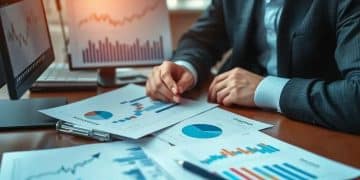Consumer confidence index trends: what to watch for

The consumer confidence index measures how optimistic consumers are about the economy, influencing their spending behavior and serving as a key predictor of economic trends.
Consumer confidence index trends play a crucial role in assessing economic health. Have you ever wondered how these trends impact your daily life? Join me as we delve into their significance and what you should keep an eye on.
Understanding the consumer confidence index
Understanding the consumer confidence index is essential for grasping how consumers feel about the economy. This index measures their optimism regarding their financial situation and the economy’s overall health. When confidence is high, consumers are more likely to spend, which can spur economic growth.
What is the Consumer Confidence Index?
The consumer confidence index (CCI) is a monthly survey conducted to assess how optimistic or pessimistic consumers are regarding their expected financial situation. It plays a pivotal role in economic analysis as it can provide early signs of economic trends.
Why It Matters
Consumer confidence affects various aspects of the economy. When people feel confident, they tend to:
- Increase their spending on goods and services.
- Invest in big-ticket items such as homes and cars.
- Support businesses by driving up sales.
On the other hand, low confidence can lead to reduced spending and economic slowdown. A healthy economy usually coincides with a high consumer confidence index.
It’s also important to note that the consumer confidence index can fluctuate based on current events. Events like job reports, government policies, and global crises can heighten or diminish consumer sentiment.
Additionally, the CCI serves as a critical tool for policymakers and businesses. They use it to gauge where to invest or cut back based on public sentiment. Understanding these dynamics can help both consumers and businesses navigate the economy more effectively.
Historical trends in consumer confidence
When exploring historical trends in consumer confidence, it’s fascinating to see how this index fluctuates over time. Understanding these trends can help us better grasp economic cycles and consumer behavior.
Key Historical Moments
Throughout history, various events have significantly impacted the consumer confidence index. For instance, economic downturns, like the Great Recession, caused sharp declines in consumer confidence. Similarly, periods of recovery often correlate with rising confidence levels. Notably, after major events such as natural disasters or political changes, consumers often reassess their financial outlook.
Data Insights
Analyzing past data reveals important trends:
- Confidence tends to drop during economic downturns.
- Recessions usually show a significant lag in consumer confidence recovery.
- Long-term increases in consumer confidence often precede economic growth.
These insights are more than just numbers; they reflect how consumers feel about their personal finances and the economy. Such sentiments can directly influence spending behaviors and the overall market health.
Additionally, the historical trends in consumer confidence can reveal patterns that predict future behavior. For example, if consumer confidence begins to rise steadily, it often indicates that consumers will spend more, leading to economic growth. Conversely, sudden drops in confidence can foreshadow a recession, prompting businesses and policymakers to respond quickly.
By studying these historical trends, we can better understand how external factors like economic policies, global events, and market changes shape consumer sentiment.
Factors influencing consumer confidence

Several key factors influence consumer confidence, shaping how people feel about their financial situation and the economy. Understanding these elements is essential for interpreting consumer trends effectively.
Economic Indicators
Economic indicators, such as employment rates, inflation, and GDP growth, significantly impact consumer sentiment. When the economy is growing and job opportunities are abundant, confidence tends to rise. On the contrary, high unemployment or rising prices can create uncertainty, leading to lower consumer confidence.
Political Environment
The political landscape also plays a crucial role in shaping consumer feelings. Major political events, policies, and leadership changes can either boost public sentiment or instill fear. For example, upcoming elections may create uncertainty, affecting spending habits.
Social Factors
Social aspects, including societal trends and consumer behavior patterns, can influence confidence as well. When individuals see their peers spending money or making investments, they may feel encouraged to do the same. Additionally, public sentiment can be influenced by media coverage surrounding key economic events.
Expectations for the Future
Another vital factor affecting consumer confidence is future expectations. If consumers believe that their financial conditions will improve, their confidence will likely rise. Conversely, if they anticipate economic challenges, this may hinder their willingness to spend.
- Employment rates and job security play a significant role.
- The state of the housing market can influence feelings about personal wealth.
- Inflation rates lead to concerns about rising costs, impacting spending.
By understanding these factors, businesses and policymakers can better respond to changes in consumer sentiment. Observing how these elements interact allows for a clearer picture of the economic landscape and consumer behavior.
The impact of consumer confidence on spending
The impact of consumer confidence on spending is profound and often immediate. When consumers feel good about their financial situation and the economy, they are more likely to spend money. This spending is crucial for fueling economic growth and business success.
Positive Effects of High Confidence
High consumer confidence often leads to increased purchasing activity. People tend to buy not just essentials but also luxury items, cars, and homes. This surge in consumer spending can create a virtuous cycle where businesses thrive, leading to more jobs and further boosting confidence.
Negative Effects of Low Confidence
Conversely, low consumer confidence can cause spending to drop sharply. When people feel uncertain about their financial future, they often cut back on expenditures. This behavior can dampen sales across various sectors and slow down economic growth.
Examples of Spending Patterns
Different spending patterns emerge based on consumer confidence:
- A surge in dining out and entertainment options during periods of high confidence.
- Increased home improvement projects when people feel secure in their jobs.
- Decreased spending on non-essential items during economic downturns.
Understanding the relationship between consumer confidence and spending is vital for businesses. Companies closely monitor consumer sentiment to predict sales trends and adjust their marketing strategies accordingly. Moreover, policymakers also pay attention to these trends to tailor economic policies that encourage spending.
The cycles of consumer confidence and spending are intertwined in a complex relationship, where each influences the other. Therefore, keeping track of changes in consumer sentiment can provide valuable insights into future economic performance.
Predictive power of consumer confidence trends
The predictive power of consumer confidence trends is significant in understanding future economic activities. These trends can serve as early indicators for various economic shifts, helping businesses and policymakers make informed decisions.
Leading Economic Indicator
Consumer confidence is considered a leading economic indicator because it often reflects anticipated spending behavior. When confidence is high, consumers are likely to increase their spending, which can drive economic growth. Conversely, declining confidence can signal a future slowdown in consumer spending.
Correlation with Economic Performance
Studies have shown strong correlations between consumer confidence and key economic performance metrics. For example:
- Rising consumer confidence typically precedes increases in retail sales.
- A drop in consumer confidence can forecast a recession.
- Changes in confidence can impact production and employment rates.
These correlations enable businesses to adjust their strategies based on consumer sentiment. Companies often use consumer confidence data to plan for inventory, marketing, and staffing needs.
Real-World Applications
Many organizations utilize consumer confidence trends to make strategic decisions. For instance, a spike in confidence may encourage businesses to invest in expansion and product development. Alternatively, during periods of low confidence, companies may cut costs to remain viable. Furthermore, policymakers rely on these trends to shape fiscal and monetary policies aimed at stimulating the economy.
Understanding the predictive power of consumer confidence trends can help both businesses and individuals navigate economic fluctuations effectively. By keeping an eye on changes in consumer sentiment, stakeholders can better prepare for what lies ahead.
FAQ – Frequently Asked Questions about Consumer Confidence
What is the consumer confidence index?
The consumer confidence index measures how optimistic or pessimistic consumers are regarding their expected financial situation and the overall economy.
How does consumer confidence affect spending?
When consumer confidence is high, people are more likely to spend money on goods and services, which can drive economic growth.
What factors influence consumer confidence?
Economic indicators, political events, and social factors such as community sentiment directly impact consumer confidence levels.
Why is consumer confidence a predictive indicator?
Consumer confidence trends can predict future spending behavior, giving businesses and policymakers insights into potential economic changes.





